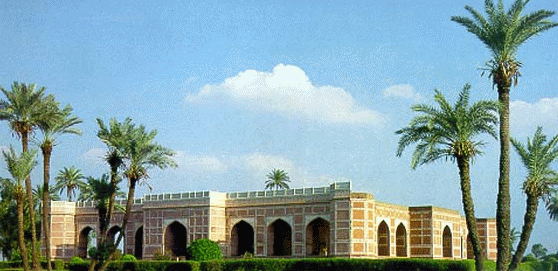
| Spouse | Sher Afghan Quli Khan Jahangir |
|---|---|
| Issue | |
| Mehr-Un-Nisaa | |
| House | Timurid |
| Father | Mirza Ghias Beg |
| Mother | Asmat Begum |
| Born | 1577 Kandahar, Mughal Empire |
| Died | 1645 Lahore, Mughal Empire |
| Burial | Shahdara Bagh, Lahore |
| Religion | Islam |
Shahdara again - on the outskirts of Lahore - a place where once royalties roamed and elephants carried the princes and princesses. Now only tomb reamin and a desolate silence. Besides Jahangir and his son in law Asif, lie buried Noor Jahan - the once most powerful royalty of the Mogul empire and the beloved wife of Emperor Jahangir. Her tomb once had a marble cenotaph which she had built herself during her life time. During the Sikh rule of Punjab, like all other Mogul buildings, this tomb was also mercilessly plundered and looted of its decorative tiles, marble and red stones, which later used for building the Golden Temple, a Sikh holy place in India (Amritsar). Whatever remained, was further ruined by the British. For they laid a railway line through the gardens of the tomb and used one part of it as a coal dump in the late 19th century.


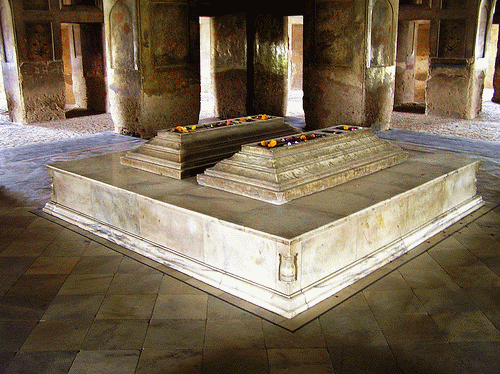
The tomb is a single story structure with no domes or minarets. It has arched hallways and in the centre are two graves; one of the Queen and the other of her daughter Ladli Begum. The tomb once lay in ruins (above left), but has been repaired to bring back its simplistic grandeur and majestic look it once wore.
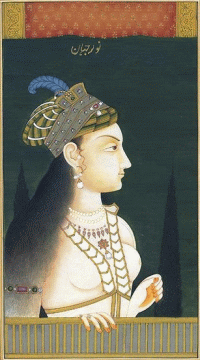 Noor Jahan was not her birth name, but a title given to her by her husband Emperor Jahangir, which means "Light of the world". Her birth name was Mehrunissa Begum (spelt as Mehr-un-Nisa). Noor Jahan's father Mirza Ghiyas Baig migrated to India with his family and in 1577, during the trip to India, Noor Jahan was born. When she grew up, she was married to a Turkish soldier, Sher Afghan Quli Khan at the age of 17 in 1594 and had a daughter, Ladli Begum. Her husband was executed in 1607 and she became the lady-in-waiting for one of Jahangir's court women and the hand-maiden at the imperial harem in Agra. On the fateful day of March 1611, she met Prince Jahangir in the spring festival of Norooz at the Palace bazaar, who straightaway fell in love with this 35 years old widow. Just two months later, both got married, and Mehr-un-Nisa became Noor Jahan. She was very intelligent, shrewd and a woman who could see into the future. That is why she is regarded by many as the real power behind the Mughal throne. She attempted to consolidate her position through her brother Abdul Hasan Asaf Khan, who was the Imperial wazir (minister). She arranged the marriage of her niece Arjumand Banu Begum, (later known as Mumtaz Mahal and the inspiration for the Taj Mahal) to Jahangir's son Prince Khurram, who later rose to the throne of India as Shah Jahan.
Noor Jahan was not her birth name, but a title given to her by her husband Emperor Jahangir, which means "Light of the world". Her birth name was Mehrunissa Begum (spelt as Mehr-un-Nisa). Noor Jahan's father Mirza Ghiyas Baig migrated to India with his family and in 1577, during the trip to India, Noor Jahan was born. When she grew up, she was married to a Turkish soldier, Sher Afghan Quli Khan at the age of 17 in 1594 and had a daughter, Ladli Begum. Her husband was executed in 1607 and she became the lady-in-waiting for one of Jahangir's court women and the hand-maiden at the imperial harem in Agra. On the fateful day of March 1611, she met Prince Jahangir in the spring festival of Norooz at the Palace bazaar, who straightaway fell in love with this 35 years old widow. Just two months later, both got married, and Mehr-un-Nisa became Noor Jahan. She was very intelligent, shrewd and a woman who could see into the future. That is why she is regarded by many as the real power behind the Mughal throne. She attempted to consolidate her position through her brother Abdul Hasan Asaf Khan, who was the Imperial wazir (minister). She arranged the marriage of her niece Arjumand Banu Begum, (later known as Mumtaz Mahal and the inspiration for the Taj Mahal) to Jahangir's son Prince Khurram, who later rose to the throne of India as Shah Jahan.Commenting on the political prowess of Noor Jahan, Stanley Lane-Poole writes in History of India, “So great was the influence of this Persian princess that Jahangir joined her name with his on the coinage, a conjunction unparalleled in the history of Mohammedan numismatics.†The wording on the coins, in Persian is worth quoting: “Ba Hukm Shah Jahangir yaft sad zewer, / Banam Noor Jahan Badshah Begum zar†(By the order of Jahangir, gold attained a hundred times its beauty when the name of Nur Jahan, the First Lady of the court was impressed upon it). Lane-Poole further says that this gifted woman ‘practically ruled the empire during the greater part of Jahangir’s reign’. Another writer, GHR Tillotson, emphasizes that Noor Jahan was the ‘most powerful woman in Mughal history, able to control state affairs from behind the purdah screen’.
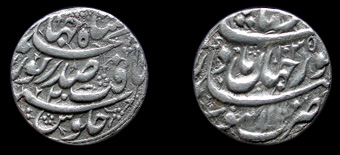
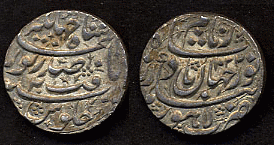
As it happens in all monarchies, sometimes the sons also rise against their fathers. So did Shah Jahan and Emperor Jahangir was captured by rebels in 1626 while he was on his way to Kashmir. Noor Jahan intervened to get her husband released. After his release, Jahangir remained alive for another year and died on 28th October, 1627. When Jahangir died, Asaf Khan took the side of his son-in-law Shah Jahan against his sister and Noor Jahan virtually became a prisoner in a small house for the rest of her life. After the coronation of Shah Jahan, Noor Jahan gave up politics and lived in seclusion. Always clad in white, all her time was spent in building the tomb of her husband and growing its garden. She died in 1645 and rests in peace with her daughter "Ladli Begum" in her tomb at Shahdara, Lahore.
Noor Jahan had numerous achievements to her credit. She excelled in a whole range of unrelated activities. She could turn a verse, appreciate a painting, design building from its architecture down to the smallest embellishment in enhancing its beauty, evolve a new style in dress, drop tigers and lions with an arrow or a bullet and sustain a conversation on any of the subjects of the day. It is because of her ‘eye’ being added to that of her husband who was one of the greatest aesthetes known to the history of mankind that Mughal painting scaled its pinnacle of glory in the period 1612-1627. Her tribute to her late husband Jahangir in the form of his beautifully laid out tomb immortalizes both for centuries thereafter. She also got a beautify tomb constructed over her father's grave at Agra, not far from the famous Taj Mahal.
Noor Jahan, besides being an avid art lover was also a brave woman when it came to real life threatening dangers. Jahangir in his memoirs recalls that once four tigers came out of the bushes near the elephant being ridden by Jahangir and Noor Jahan. The Emperor looked at his lady and whispered, “Yours!†She asked in gestures, “Arrow or Bullet?†In order not to make a sound and thus disturb the very sharp-eared animals the Emperor raised two fingers put them down and raised them again. Noor Jahan understood that he wanted to have her shoot two with bow and arrow and two with the gun. She loaded two guns and kept them ready, resting on the howdah. Then she took up her bow and selected two arrows. In the twinkling of an eye she raised the bow and in quick-fire action let fly two arrow at the tigers. Her aim was unerring and two large beasts fell with arrows stuck in their hearts. She then picked up the two guns in quick succession and dropped a tiger with each shot.
As for herself, Noor Jahan built a very small tomb for her own final abode, and the verse she wrote for it is to be the part of the repertoire of every one with any vestige of the heritage of Mogul Empire.

Sahir -Noor Jahan Ki Mazar Par-Pahloo-E-Shaah Mein Ye Dukhtar
Pahloo-E-Shaah Mein Ye Dukhtar-E-Jumhoor Ki Qabr
Kitne Gumgashta Fasaanon Ka Pataa Deti Hai
Kitne Khoonrez Haqaaiq Se Uthaati Hai Naqaab
Kitni Kuchli Hui Jaanon Ka Pataa Deti Hai
Kaise Maghroor Shahan-Shaahon Ki Taskin Ke Liye
Saal-Ha-Saal Haseenaaon Ke Baazaar Lage
Kaise Bahki Hui Nazron Ke Ta’ayyush Ke Liye
Surkh Mahlon Mein Jawaan Jismon Ke Ambaar Lage
Kaise Har Shaakh Se Munh-Band Mahakti Kaliyaan
Noch Li Jaati Thin Taz’in-E-Haram Ki Khaatir
Aur Murjha Ke Bhi Aazaad Na Ho Sakti Thin
Zill-E-Subhaan Ki Ulfat Ke Bharam Ki Khaatir
Kaise Ik Fard Ke Honton Ki Zaraa Si Jumbish
Sard Kar Sakti Thi Be-Laus Wafaaon Ke Chiraagh
Loot Sakti Thi Damakte Hue Haathon Ka Suhaag
Tor Sakti Thi Mai-E-Ishq Se Labrez Ayaagh
Sahmi-Sahmi Si Fazaaon Mein Ye Weeraan Marqad
Itna Khaamosh Hai, Faryaad-Kunaan Ho Jaise
Sard Shaakhon Mein Hawaa Cheekh Rahi Hai Aise
Rooh-E-Taqdees-O-Wafaa Marsiyaa Khwaan Ho Jaise
Tu Meri Jaan! Mujhe Hairat-O-Hasrat Se Na Dekh
Ham Mein Koi Bhi Jahaanoor-O-Jahaangeer Nahin
Tu Mujhe Chhod Ke Thukraa Ke Bhi Jaa Sakti Hai
Tere Haathon Mein Mire Haath Hain, Zanjeer Nahin
------------------